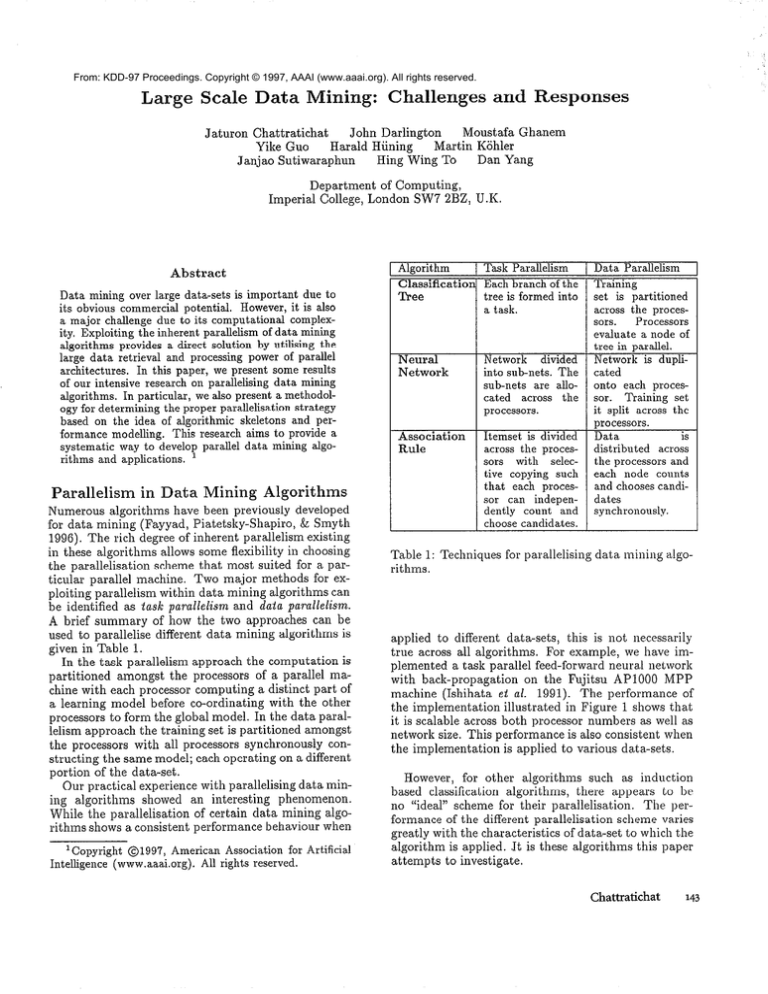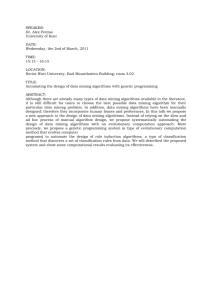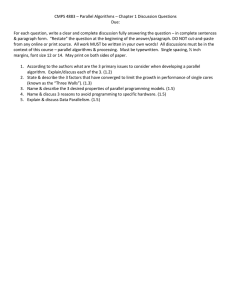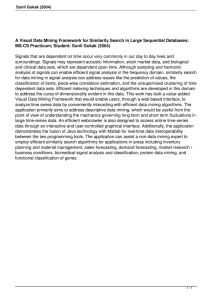
From: KDD-97 Proceedings. Copyright © 1997, AAAI (www.aaai.org). All rights reserved.
Large
Scale Data
Mining:
Challenges
and Responses
Moustafa Ghanem
John Darlington
Martin Ktjhler
Harald Hiining
Dan Yang
Hing Wing To
Janjao Sutiwaraphun
Jaturon
Chattratichat
Yile Guo
Imperial
Department
of Computing,
College, London SW7 2BZ, U.K.
Abstract
Data mining over large data-sets is important due to
its obvious commercial potential, However, it is also
a major challenge due to its computational
complexity. Exploiting the inherent parallelism of data mining
algorithms provides a direct solution by utilising the
large data retrieval and processing power of parallel
architectures.
In this paper, we present some results
of our intensive research on paralielising data mining
algorithms. In particular, we also present a methodology for determining the proper parallelisation strategy
based on the idea of algorithmic skeletons and performance modelling. This research aims to provide a
systematic way to develop parallel data mining algorithms and applications. ’
Parallelism
in Data
Mining
Algorithm
Classificatior
Tree
Data Parallelism
Training
set is partitioned
across the procesProcessors
sors.
evaluate a node of
tree in parallel.
Network is duplicated
onto each processor. Training set
it split a.cross the
nrocessors.
Data
is
distributed
across
the processors and
each node counts
and chooses candidates
synchronously.
tree is formed into
a task.
Neural
Network
Network
divided
into sub-nets. The
sub-nets are allocated across the
processors.
Association
Rule
Itemset is divided
a.cross the processelecsors with
tive copying such
that each processor can independently count and
choose candidates.
Algorithms
Numerous algorithms have been previously developed
for data mining (Fayyad, Piatetsky-Shapiro, & Smyth
, nnc\ n-1...:-1. uc:grcr;
A^,....^^ “I-P IIIIItxGIIb
:.,L.,,,,* palculGlmul
-nnn ,,,,;nm LuDUllltj
^“;,+;,,,.
I Ilt: llCll
IYYU).
in these algorithms allows some flexibility in choosing
the parallelisation scheme that most suited for a particular parallel machine. Two major methods for exploiting parallelism within data mining algorithms can
be identified as task parallelism and dafa parallelism.
A brief summary of how the two approaches can be
used to parallelise different data mining algorithms is
given in Table 1.
In the task parallelism approach the computation is
partitioned amongst the processors of a parallel machine with each processor computing a distinct part of
a learning model before co-ordinating with the other
processors to form the global model. In the data parallelism approach the training set is partitioned amongst
the processors with all processors synchronously constructing the same model; each operating on a different
portion of the data-set.
Our practical experience with parallelising data mining algorithms showed an interesting phenomenon.
While the parallelisation of certain data mining algorithms shows a consistent performance behaviour when
Task Parallelism
Each branch of the
-1
Table 1: Techniques for parallelising
rithms.
data mining a.lgo-
applied to different data-sets, this is not necessarily
true across all algorithms. For example, we have implemented a task parallel feed-forward neural network
with back-propagation on the Fujitsu APlOOO MPP
sLzc&np,
fTchihat.n
d-“.-“y ~-~~
nerfmmn
of
I____
-__-1
\“L”L’
.,”
nl
1441).
The
the implementation illustrated in Figure 1 shows that
it is scalable across both processor numbers as well as
network size. This performance is also consistent when
the implementation is applied to various data-sets.
However, for other algorithms such a.s induction
based classification algorithms, there appears to be
no “ideal” scheme for their parallelisation.
The performance of the different parallelisation scheme varies
greatly with the characteristics of data-set to which the
algorithm is applied. It is these algorithms this paper
attempts to investigate.
’&pyJvrieht
fi31997.
A_ssc&&ion
for
Artificial
o-sv-->.A_r?leric~-
Intelligence
(www.aaai.org).
All rights reserved.
Chattratichat
143
Execution times of the PaKtllBl back-pr0PagHOn 0” API ooo
450
s,
400 i
‘,
‘;
‘.,,
\
:b,
300.
\
.,
‘...
..
250 . ;
“b.,,
i
I.
200 l,,
‘3......~ ,.
\
350 .\
Topology:14’3P20’3 +-Topology:14’50’50*3 -+-- Topology:14*100’50*3 ‘-W-”
D---Q ......~ .._..o Q ..... .~ ..,I
~~‘.~~~~~~+~~-.*.....L
. . ..__* .__._
+ ___,_
+ ___.
~_t._____
c _____.
01
2
7
I
4
6
6
10
Number of processors
12
14
Figure 1: Execution time of PNN on the AP1000.
Parallelising
Classification
Algorithms
In this section, we describe our experiments in parallelising a well known tree induction algorithm;
C4.5 (Quinlan 1993). The aim of these experiments
was to gain a deeper understanding of the different
parallelisation schemes for classifica.tion algorithms.
C4.5 is a classification-rule learning system which
rlwisinn
IIQO,C
L&vu.,
U”“IL.IVII ~IVPE
“I”.><2as 2 mode! representat!;t!ion.Tile tree
models are inferred by using an inductive learning approach applied to a training set. C4.5 attempts to find
the simplest decision tree that describes the structure
of the data-set by using heuristics based on information theory, These decide which attribute to select for
any given node based on its information gain, i.e. its
ability to minimise the information needed to further
classify the cases in the resulting sub-trees. In our experiments we have implemented both task and data
pa.rallel versions of C4.5.
Task Parallel Implementations
Several schemes
for exploiting task parallelism between the branches of
the decision tree exist. W e a.dopted a Dynamic Ta.sk
Distribution Scheme (DTD) where a master processor
maintains a queue of idle slave processors. The subtrees generated at the root of the classification tree
are initially dispatched for execution on distinct slave
processors. Any slave processor expanding an internal
node can also allocate its generated branches to other
slaves by initiating a request to the master processor.
Data Parallel
Implementations
Two variations
of data parallel (DP) scheme can be used with C4.5.
Given a d&a-set with size N of t-dimensional
data,
the entire work load of the algorithm can be characterised by N x k. W e have implemented two data parallel C4.5 systems, the first (DP-ret) starts by distributing the data-set N across P processors such that each
processor is responsible for N/P records each containing the full k attributes. The second scheme (DP-att)
distributes the L attributes across the processors such
that each processor is responsible for N records each
of k/P attributes.
In both schemes all the processors co-operate in
144
KDD-97
a SPMD (Single Program Multiple Data) fa.shion in
the computation required to expand a particular node.
Each processor begins by computing the same function
over its local portion of the data-set. The processors
then synchronise by exchanging their local information
to create a global view of the node computation. the
process continues until the full tree has been expanded.
The three schemes have very different execution
characteristics. The DTP scheme benefits from the
independence between the different ta.sks executed in
parallel but is sensitive to 1oa.dba.lancing problems resulting from poor distribution of da.ta elemerns I:)(‘tween branches of a. tree. The DP-ret i1111~I~117r’1lt,il.tion suffers from high communication overheads as the
depth of the tree increa.ses, but, shoulcl perform we1I
with large data sets. The DP-attr scheme has the
advantages of being both load-balanced and requiring
minimal communicat~ions. It is however not, generally
scalable with the number of processors.
Performance
Results
The performance ol’ lhe different implementa.tions were compa.red using the SOYBEAN, MUSHROOM and (~NNECT-4
trainiq
sels oh-
tamed from the IICI Repository of Machine Learning
Database (‘Merz k Murphy 1996). Both the chara,ct.eristics of the different data-sets used in the experimems
and the measured execution time of the experiments
for a varying the number of processors from 2 to 16.
are shown in Figure 2. Note that k is the number of
attributes in record, c is the number of classes and N
is the number of cases used in the training set.
The results mainly indicate that the choice of the
best pa.rallelisation strategy highly depends on the
data-set being used. For the CONNECT-4 data-set the
DTD scheme offered the best performance. This can
be attributed to the dense shape of the generated tree
where the a.ddition of more processors a.llows the execution of more nodes in para.llel. For the SOYBEAN
data-set, the DP-attr version offered the best performance. This version outperforms the DP-ret scheme
due to the large number of classes and attributes which
govern the amount of data being exchanged in the DPret scheme. In contrast using the MUSHROOM da.ta-set,
the DP-ret scheme offered the best performance where
the data set is characterised by a large training set and
low number of classes and attributes.
Structuring
Parallel
Data M ining
The experiments presented in the previous section
highlight some of the difficulties faced when develop.~ ~~1 1.
ing efficient impiemen-ca~lons
of paraiiei data mining
programs where the choice between different pa.rallelisation methods depends on the characteristics of the
target machine architecture. This “dynamic” algorithmic behaviour is one of the major challenges for parallelising data mining applications.
At Imperial College we have been developing a structured approach to parallel programming based on the
DC(simple, solve, divide, combine, P ) =
if simple (P) then solve (P)
else
combine (n, Farm(simple, solve,
divide, combine Si))
where
(n, S) = divide (P) Si E S
Connect
k=42, c=3.
N=27558.
In this skeletons, the functions simple performs a triviality test on a given ta.sk. If the task is trivial it is
then solved by the function solve. Otherwise the larger
tasks are divided by the function divide into a set of
sub-tasks S and a node n. These sub-tasks solved recursively and the sub-results combined by the function
combine . The task parallel implementation of the D&C
skeleton is specified by the Farm skeleton which captures the behaviour of executing a set of independent
tasks in parallel.
By decomposing C4.5 into four basic functions a.
task parallel tree construction procedure of C4.5 can
be structured as a. special instance of the D&C skeleton. The functions are: class for computing the set of
for selecting
class values of a data-set, select-attribute
attribute by computing the information gain and test
for partitioning the data. by logical test on the selected
attribute. The algorithm can be specified thus:
Mushroom
k22,
c=2,
N=24372
(scaled-up).
Soybean
k=35, c=19.
N=170'75
(scaled-up)
Figure 2: Execution time of different data-sets on the
APlOOO
use of high-level skeletons (Darlington et al. 1995;
Darlington, Ghanem, & To 1993). The approach offers a solution to the above challenge by making the
choice of the appropriate parallelisation strategy based
on the characteristics of the data-set much easier.
Structured
Parallel
Programming
At the heart of our structured
n,.v.,r,nnL
qJp’“aL”
:, CL,..
1u bIIG
n,...In,\n+
L”rlLcz,Jb
parallel programming
-cm
n,-.+ ,c.,..,&.F:,,,-l
“I a 31;b “I ~J’~U’;““~U
l,:nl.
l.-...*l
‘lltjll-II;“I;I
skeletons. A skeleton can be viewed as a software template that specifies a particular pattern of parallel computation and communication. Each skeleton captures
a widely used parallel method which is often common
to a wide range of applications. A parallel program
is first expressed by choosing a skeleton which reflects
the parallel structure of the program. The parameters of the skeleton are then instantiated with problem
specific sequential function calls.
For example, The D&C skeleton captures the recursive divide and conquer behaviour common to many
a.lgorithms such as C4.5. These algorithms work by
splitting a large ta.sk into several sub-tasks, solving
the sub-tasks independently and then combining the
results. Since the sub-tasks are independent, they can
be executed on separate processors. A functional specification of the D&C skeleton is as follows:
Parallel-nee-Construction
(S) =
DC (simple, solve, divide, combine, S)
where
simple S = is-singleton (class (S))
solve S = class (S)
divide S = test (select-attribute (S))
combine n T = node( n, T)
Navigating
using Performance
Models
Skeletons are mainly used to provide a precise abstraction of computational behaviour of a parallel implementations while hiding their implementa.tion deta.ils.
The
natkernn
II~~
-___-
nf
-_
nardlelism
=-----------
ca.nt.nred
--I- -----
hv
-.J
ea.&
&ek-
ton are quite general. The exact implementation of a
given skeleton may change from one parallel machine
to another to make use of a given machine’s features.
However the use of skeletons to express the control
structure of a parallel program enables the capluring
of the main features of a pa.rallelisation stra.tegy. This
provides a crucial a.id in determining the appropria.te
choice of hot811 a. parallelisa.tion scheme and it,s unclcrlying implementation.
One of the main advantages of the skeleton a.pproach
is the ability to associate performance models wit811
each skeieton impiementation a.nd machine pa.ir (Darlington et al. 1996). Tl zis is due to the pre-design of
each skeleton implementation which enables the development of a performance formula predicting its tuntime performance. For example, the performance of
Chattratichat
145
divide and conquer algorithms can be specified recur&VPIV
,x”‘,‘J
in
111 tormc2
YCLIIII> rrf
VI L.N , the
U.-V nlmhl~m
r A--I “.--
&p,
-,!?
the
I---
hra.n&
_ _______
ing factor and the total execution times of division
and combination routines at a given node, Tnode(N, B).
The performance of the task parallel implementation
is
Conclusions
In this paper we have investigated the potential for
exploiting different parallelisation strategies for a classification algorithm. The results show that the per- : -2
dlfterent implementation schemes was
formance of
highly susceptible to the properties of the training set
used. We have presented a methodology based on
skeletons and performance models which provides an
aid to the user for navigating the space of parallel implementations of a given a.lgorithm solving a particular problem. We are currently investigating the precise
modelling of the implementations and building up the
correlation between the performance of these implementations and the data features.
the
where
This performance model does not give absolute predictive execution times, but is designed to be sufficient
for distinguishing between the use of alternative implementations (Darlington et al. 1996). Thus they can be
used to help the user navigate through the space of all
possibie impiementations, without the need to execute
the code. This property is the key to determine the
choice of right parallel implementation of a data mining algorithm with respect to a particular application.
Structured
Parallelisation
of C4.5
AC
an
PY~III~~P
ef
1~~1111r
t.he
&e]ef;om
a.pproa&
2II, 1-A“‘.uA’-Lc-0 ---- .-
the different parallelisation strategies for the C4.5 classification a.lgorithm ca.n be implemented using the skeletons
shown in Figure 3. Each pa,th in this option tree specifies a possible implementation of the program in terms
of skeletons.
!-
Figure 3: C4.5 parallelisation
road map
For a.lgorithms such a.s C4.5 where the characteristics of the data-set affect the performance of the different implementations, the rela.tionship between the
skeleton performance models and the data-set needs
to be developed. This can be done by examining the
size of the da.&set (scale), the number of attributes of
the data (complexity), the ratio between the number
of continuous attributes and the number of discrete attributes (structure of the data-set) and the characteristicn
d-_I of
- _ the
1--_ nrohlem
r-- ----- domain (structure of the tree). The
correlation between the performance models of parallel
146
data mining systems and the feature model of the da.taset provides a decision model of determining a. 1oroner
m-1.
parallel implementation for a particular problem.
KDD-97
References
Darlington, J .; Guo, Y.; To, H. W .; and Yang, J,
1995. Functional skeletons for parallel coordination.
In Haridi, S.; Ali, I(.; and Magnussin, P., eds., Euron--1nr
n ..,....
11.1rroces:szng,
n-.-- .-.
r(~‘
f. yil rur’
ulcci
55-69. Springer-Verlag.
Darlington, J.; Ghanem, M.; Guo, Y.; and To, H. W.
1996. Guided resource organisation in heterogeneous
parallel computing. Submitted to the Jour&
of High,
Performance Computing.
Darlington, J.; Ghanem, M.; and To, H. W. 1993.
Structured parallel programming.
In Programming
Models for Massively Parallel Computers, 160-169.
IEEE Computer Society Press.
Fayyad, U. M.; Piatetsky-Shapiro, G.; and Smyth, P.
1996. From da.ta mining to knowledge discovery: An
overview. In Fayyad, U. M.; Piatetesky-Sha.piro, G.;
Smyth, P.; and Uthurusamy, R., eds., Advances in
Knowledge Discovery and Datu Mining. MIT Press.
Ishihata, H.; Horie, T.; Inano, S.; Shimizu, T.; Kate,
S.; and Ikesaka, M. 1991. Third generation message
passing computer APlOOO. In Interlaational Sympo&urn on Supercomputing, 46-55.
Merz, C. J., and Murphy, P. M. 1996. UC1 repository
of machine learning databases. University of Ca.lifornia,
Department of Information and Computer Science,
http://www.ics.uci.edu/“l?lllearll/MLRepository.~~t~~ll.
fL.:..1-..
yulLu*u,
J.
R.
1993.
f-7,
bi+.;,
Lennzing. Morgan Kaufmann
r
l-l-&-..-
r7’UQ’l’UlllS
__^^
I'...
JO7’
nc.
-1
'~.
M UCIl.Z’JLC
Publishers, Inc.








